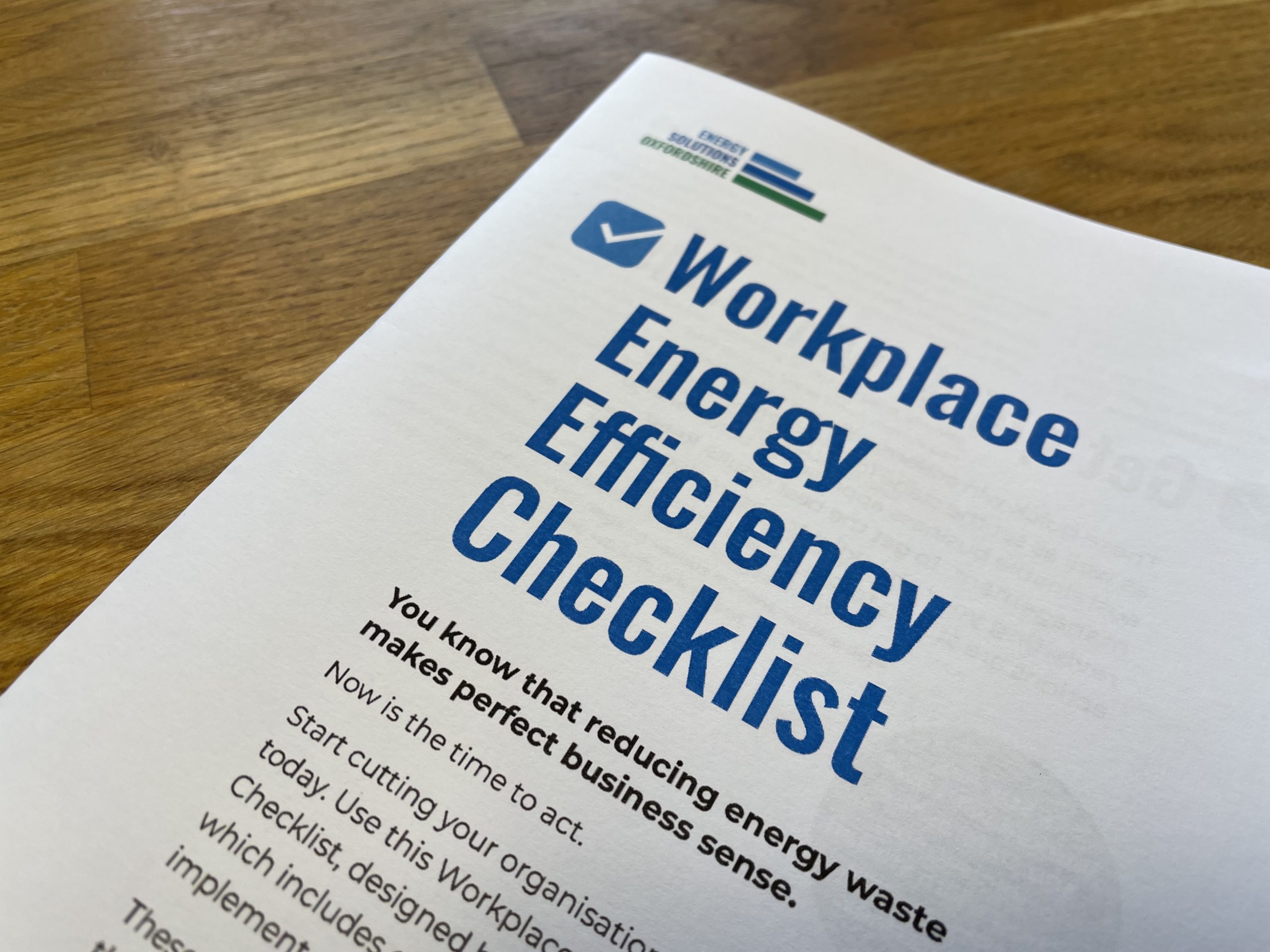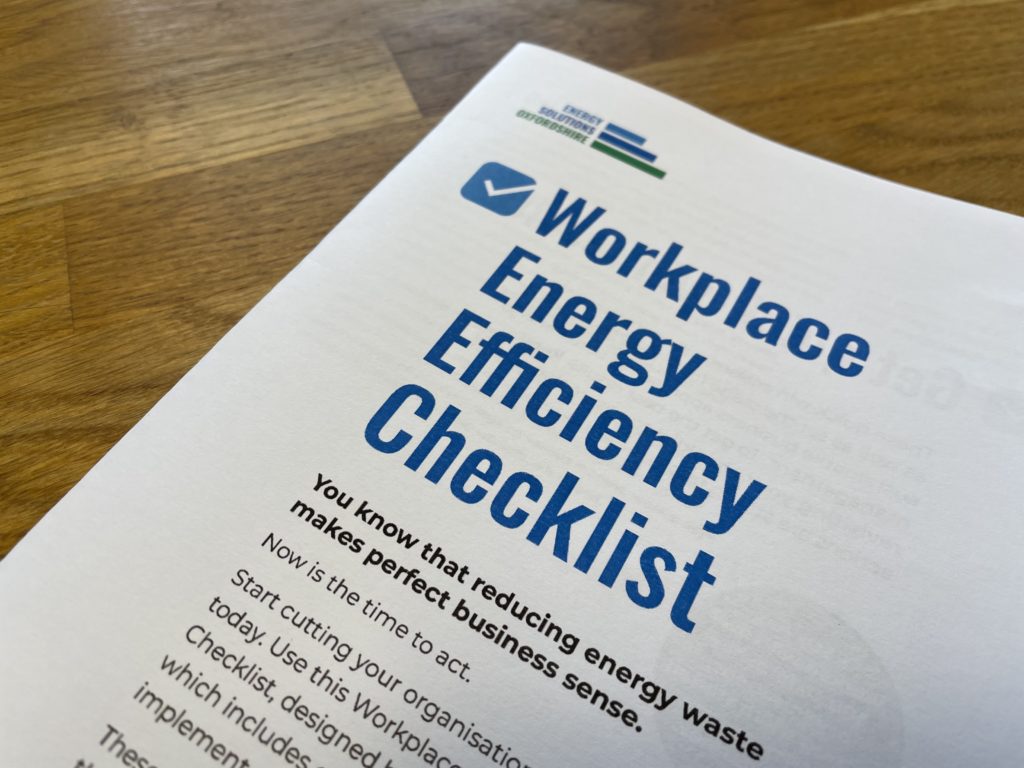
Your free Workplace Energy Efficiency Checklist
Get started
Use this Workplace Energy Efficiency Checklist below, designed by the ESOx team of experts, which gives you a list of simple quick-win actions that help with those important first steps of your energy efficiency journey.
For your convenience and to keep things organised, just click here to download the PDF version of the checklist. If you’re based in Oxfordshire and prefer to have a printed copy, feel free to get in touch with our team. We’ll happily send one your way.

Alternatively, get a comprehensive Workplace Energy Efficiency Assessment, which will give you far more tailored advice and more detailed, business-specific insights.
Get quick-win results
These quick-win actions will save you energy – as well as set the stage for a more long-term, sustainable business approach to better energy management. Download this checklist to tick your way through the list. To get the best results, keep revisiting your checklist to ensure that all your actions are still on track!
First, get data
To start your energy efficiency journey, you need data – the more, the better. Any info about how much energy you use now will help give you a baseline to measure the difference your efficiency changes make. This data will also be really useful for setting long-term goals and planning for bigger improvements down the line.
> Your energy data
- Current energy use: Get hold of actual data (not estimates) of energy used, in units like kWh, such as meter readings/bills. Some smart meters can provide half-hourly meter readings which will help you measure energy usage throughout the day (a third-party app may be needed if your electricity provider does not make that data available to you).
- Analyse energy use: Set up a routine to gather and check your energy data. It’s best to do this regularly, like once a month, to take account of seasonal patterns. With more detailed data, you can analyse energy use patterns based on building usage on various months, weeks, days or even the periods when your workplace is closed.
Get organised
Think about what you want to achieve. Focus on defining your energy management approach. This will help ensure effective communication, tracking, and continuous energy efficiency improvements.
> Set goals
- Develop a strategy, with clear targets for managing your building’s energy use going forward.
- Have documented procedures to manage day-to-day energy use, including logging any improvements made, so you can check them against the data collected.
- Agree whose responsibility it will be to oversee day-to-day energy use, for example, a building caretaker.
- Decide how to measure overall progress against your targets and set up regular reviews – this can also help with communications.
- Agree whose responsibility it will be to lead on strategy and reviews, for example, a committee member or trustee, an interested volunteer, green champion, or the building caretaker.
Get people onboard
When implementing any energy efficiency measure, the most vital element to remember is people – from your staff and suppliers to partners and customers. Effective communication about your goals and the reasons behind them is essential, as their active involvement will be the driving force for success.
Don’t forget to share and celebrate your successes!
> Internal communications
Getting your employees on board is one of the simplest ways to implement energy-efficient behaviour – they are the people involved in your business every day, so if they all make small changes, they will help to create bigger results. You could even write energy saving targets into job descriptions.
- Ensure your management committee regularly reviews the strategy for making the building work more efficiently when it comes to energy and move towards Net Zero carbon emissions as soon as possible.
- Ensure that training is regularly updated and reiterated when necessary. This might occur when new individuals join, when new technologies are adopted, or even when a reminder proves beneficial.
- Share any targets you have set with those using and helping run the building, as well as updates on how it is going – say ‘thank you’ when improvements are made or targets met.
- Include people who are in your workplace out-of-hours, such as cleaners.
> Communicating with the community
It can be useful to have evidence of your building’s environmental impact designed to demonstrate to your team, customers, partners, and the public your commitment to reducing energy usage and being part of the fight against climate change.
- Communicating your energy efficiency drive. This could help with marketing your business to potential new customers who may be interested in your commitment to sustainability and the fight against climate change.
- Added publicity opportunities: Is there a local Net Zero plan where you are? Oxfordshire has a Pathways to a Zero Carbon Oxfordshire (PDF) strategy set out. Several communities and Parish Councils are developing their own local plans. Is there one in your area?
Get implementing!
Once you have your data at your fingertips, an energy strategy, and all people on board, it is time to start on some improvements.
> Small actions, big results
There are quite a few low-cost measures that will help you take control of energy use – quick-wins for reducing energy bills and cutting carbon emissions
- Check your energy supplier. Is your energy sourced from renewable sources? If not, consider switching to a provider specialising in renewable energy at a competitive tariff.
- Checking the building for draughts and adding appropriate draught proofing, looking in particular at windows and external doors. Long-term, do they perhaps need upgrading?
- Replace old-style lighting with LED lights, which use 60% less energy. This, coupled with an extended lifespan, will save your business a huge amount of energy.
- Install thermal blinds or curtains to help retain heat in cold weather and prevent overheating from direct sunlight. Thermal blinds can offer up to 20-40% reduction in heat loss in the colder months, as well as reducing heat entering your building in the summer.
- Upgrade heating controls so they can be easily set to match the times people are in the building, and you are not heating empty rooms.
- Review hot water used in your building, including boilers for drinks, so they are well managed and not left on 24/7.
- Switch off items that are unnecessarily on standby, and actively manage other appliances. Timers or smart plugs can be useful controls to help you stop wasting energy.
Get downloading
What are you waiting for? You know that reducing energy usage makes perfect business sense. Now is the time to act.
Downloadable the PDF copy of the Workplace Energy Efficiency Checklist, so you can include it in your team meetings, and tick your way through the initial quick-win process.
The next step…
Once you have implemented these initial quick-wins, you’re ready for the next part of your journey. Get a deeper understanding of business-specific actions you can take to increase your energy efficiency even further with a comprehensive Workplace Energy Efficiency Assessment. This will give you insights into customised actions you can take to achieve the best results.
